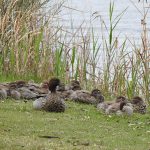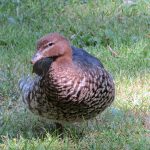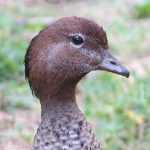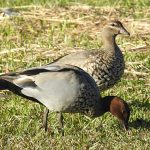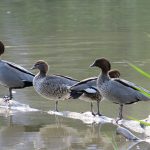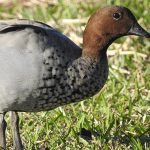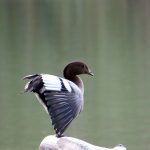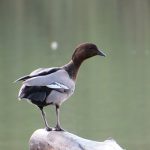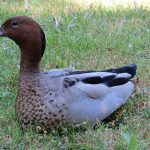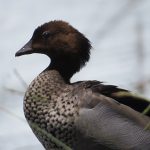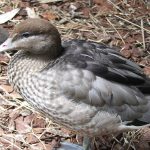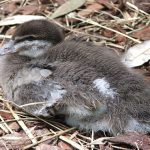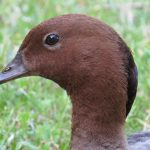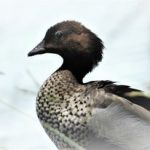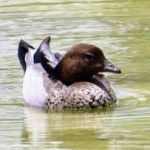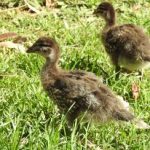AUSTRALIAN WOOD DUCK
The Australian Wood Duck: A Story of Adaptation and Survival
The Australian Wood Duck is a unique and captivating species of waterfowl, native to the diverse landscapes of Australia.
Appearance and Identification
Imagine standing quietly by a tranquil pond at dawn. Through the gentle mist, you might catch sight of a pair of Australian Wood Ducks gliding across the water. Their appearance is striking:
- Males: Display a dark chocolate-brown head and neck, contrasting beautifully with a grey body adorned with fine, black and white patterns. The subtle iridescence of their feathers shimmers in the early light.
- Females: Feature a paler brown head and neck, with delicate, speckled grey-brown plumage, blending seamlessly with the reeds and grasses.
- Both Sexes: Share a small, elegant crest at the back of the head—almost like a crown—adding a touch of regality to their profile.
Their soft rustling as they move through the grass, coupled with the gentle scent of damp earth and eucalyptus, creates a vivid sensory experience for any observer.
Habitat and Range
The Australian Wood Duck is a true traveller across the continent:
- Widespread Distribution: Found throughout mainland Australia and Tasmania.
- Diverse Habitats: Occupy wetlands, marshes, swamps, open grasslands, and even urban parks where water is present.
- Adaptability: Frequently seen foraging in agricultural fields and resting in city parks, showcasing their remarkable ability to thrive alongside human activity.
Their presence is often signalled by soft, whistling calls and the gentle ripple of water as flocks move between feeding grounds and tree-hollow nests.
Feeding and Behaviour
A day in the life of an Australian Wood Duck is a blend of quiet grazing and alert social interaction:
- Diet: Primarily herbivorous, they favour tender grasses, seeds, and aquatic plants. Their broad, flat bills are perfectly adapted for grazing and sifting through shallow water for small invertebrates.
- Foraging Habits: These ducks often feed in groups, their heads bobbing in unison as they move across dewy meadows at sunrise.
- Social Structure: Highly social, they are commonly observed in pairs or small family groups, communicating with soft, melodious calls.
Their diurnal nature means they are most active during daylight, often seen resting or perching on tree branches, an unusual habit for a duck and a testament to their adaptability.
Breeding and Family Life
The story of the Australian Wood Duck’s family life is both heartwarming and fascinating:
- Monogamy: These ducks form long-lasting pair bonds, often seen together year after year.
- Nesting: Preferring tree hollows—particularly in large eucalyptus trees near water—females carefully line their nests with down.
- Eggs and Incubation: A typical clutch contains 8-12 creamy white eggs. Both parents share the responsibilities of incubation, a rare trait among ducks.
- Duckling Care: Upon hatching, tiny, down-covered ducklings are gently guided by their parents from the nest to nearby water, where they learn to forage and evade predators under watchful eyes.
The soft peeping of ducklings and the vigilant calls of adults create a symphony of life around water bodies during breeding season.
Conservation and Coexistence
Although not globally threatened, the Australian Wood Duck’s existence is intertwined with the health of Australia’s natural landscapes:
| Threat | Impact |
|---|---|
| Habitat Loss | Wetlands and grasslands face conversion to agriculture or urban development, reducing safe nesting and feeding grounds. |
| Pollution | Runoff from farms and cities can degrade water quality, impacting food availability. |
| Human Disturbance | Increased presence of people and pets near nesting sites can lead to nest abandonment. |
Conservation Message
By protecting wetlands, preserving old trees with nesting hollows, and maintaining clean water sources, we can ensure that the gentle presence of the Australian Wood Duck continues to grace our parks and wild places. Each encounter with this adaptable bird is a reminder of the delicate balance between nature and human progress, and the shared responsibility we have to safeguard these habitats for generations to come.
he Australian Wood Duck is more than just a common sight across the continent—it is a symbol of resilience and adaptability in Australia’s diverse ecosystems. Through thoughtful stewardship and an appreciation for the natural world, we can support the continued survival of this elegant species, ensuring its story remains part of Australia’s living heritage.

